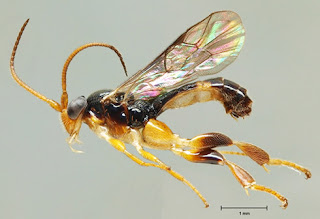 |
| © Live Science |
Oct 3, 2012 | Live Science
Little is known about tropical parasitic wasps in the subfamily Orthocentrinae besides their gruesome lifestyle. They lay their single egg in the body of a fly maggot and as the baby wasp larva grows, it eats the body of its host from the inside out.
Now researchers say they've discovered a surprising diversity of the group in South and Central America.
Scientists examined 1,549 Orthocentrinae wasps that were collected in Guatemala, Honduras, Nicaragua and the Amazon rain forests of Ecuador. From this group, they identified at least 177 distinct species — far more than the 14 currently described in the region and more than the 151 species known in North America, where they have been more thoroughly studied.
These parasitic wasps, which are just a few millimeters long, were believed to be more diverse in temperate climates. But study researcher Gavin Broad said the new findings challenge that assumption.
"We now have good evidence that these wasps are very diverse in the tropics and we should take that into account when looking at patterns of biodiversity across the globe," Broad, a wasp expert with the Natural History Museum in London, said in a statement. He added that the diversity of species could reveal more about the subfamily's place in the ecosystem.
"Considering the numbers of these wasps that can be found in forests, they must be playing an important role in the complicated cycle that breaks down dead wood," Broad explained.
"The fungi break down wood, as well as leaves and other organic debris. The flies eat the fungi and the orthocentrines feed on the flies — there is a complicated and delicate pyramid of interactions supported by the presence of dead wood and leaf litter in the forests."
Broad and his colleagues identified the wasps through DNA tests and differences in the specimens' physical characteristics. Their findings were published in the journal Proceedings of the Royal Society B Wednesday (Oct. 3) and they say their next step is to properly name and describe the new species.

No comments:
Post a Comment